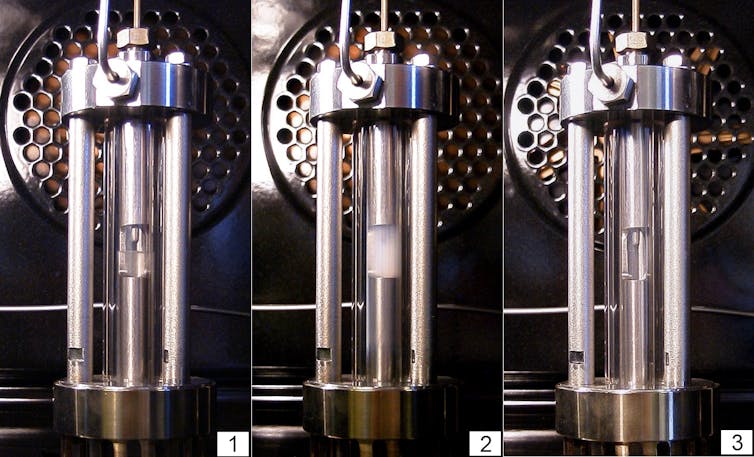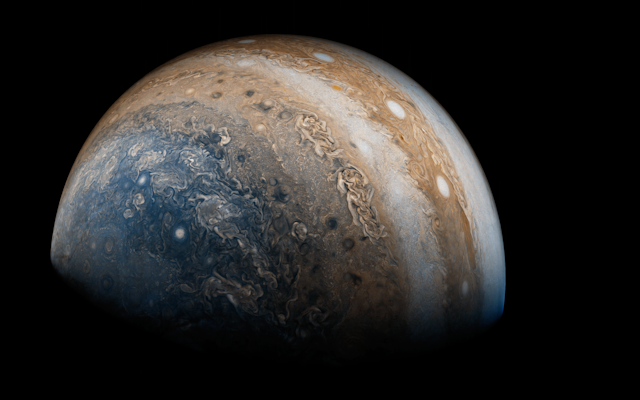The temperature and pressure inside Jupiter range from about -100°c near the edge to about 15,000°c and 50m times the Earth’s atmospheric pressure in the middle. Saturn, Uranus and Neptune are similar pressure cookers. As we descend into Jupiter, we may see matter in the gas state, in the liquid state and in another, less well-known state, called the “supercritical fluid” state.
Understanding supercritical fluids is not only important for planetary scientists, it is also used in industrial processes such as power generation and food processing.
When we boil water on Earth, it changes “phase” going from a liquid to a gas state. This is due to a sudden dramatic change in the density and other properties called a “phase transition”. However, if you squeezed water to 1,000 times atmospheric pressure and then heated it while keeping the pressure on, you would no longer observe boiling as such. The water molecules would whizz around with more energy, and the density would gradually go down, but there would be no sudden boiling (phase transition). This is what constitutes the supercritical fluid state – it’s neither a liquid nor a gas.
Exactly how liquids and supercritical fluids behave has caused scientists to scratch their heads for decades. But new research has shed light on this problem, raising hopes that we can soon gain a much better understanding of what goes on deep inside the giant gas planets.
Scientists have long assumed that liquids and supercritical fluids behave like dense gases, with molecules constantly moving around freely. But in the 1930s, the Russian physicist Yakov Ilyich Frenkel questioned this assumption, proposing that under certain conditions they would instead behave like solids (where atoms are stuck), except that the atoms occasionally hop from place to place. We can call liquids and supercritical fluids under these conditions “dense liquids”.

Ignored for decades, this approach has got a second life in the last decade as it has been successfully used to predict the heat capacity of liquids. Heat capacity is a crucial property of liquids, determining the way heat is stored and flows around planets, power stations and everything in between.
A dividing line (the “Frenkel line”) should therefore be drawn, up to arbitrarily high pressures and temperatures, between conditions where dense liquids behave similarly to gases, and conditions where Frenkel’s approach – assuming similar behaviour to solids – is valid. But how should the line be defined? How sudden is it? These questions need to be addressed by experiments.
Powerful experiments
This year, two groundbreaking studies have been published in which this line has been charted from observations. In the first study, one of the most powerful synchrotron light sources in the world (the Advanced Photon Source near Chicago) was used to pin down the pressure – 6,500 times the Earth’s atmosphere – at which one of the most fundamental model fluids, supercritical neon, starts to behave as a dense liquid as modelled by Frenkel.
In the second study, data from another powerful X-ray source (the European Synchrotron Radiation Facility in Grenoble) was combined with measurements in my laboratory in Manchester to determine the way in which the atoms in methane molecules vibrate to make a similar observation. We found that the methane starts to behave as a dense liquid at about 2,000 atmospheres pressure.
We found that one key piece of evidence in the puzzle was already there in the literature, dating back to 1986; a demonstration that the vibrations in gaseous methane behave in completely the opposite way to vibrations that we are used to seeing in dense liquids and solids. Its importance had simply not been recognised.
Our study had an added bonus compared to the neon study – methane is everywhere in our solar system. The gas giants Uranus and Neptune are full of it, and perhaps understanding methane will answer a lot of the mysteries these planets pose. Planetary scientists have lost sleep for decades over questions such as how the composition changes as you delve into Uranus and Neptune and whether Uranus’ surface really is the coldest place in the solar system.
The hope is now to apply these new results on the liquid and supercritical fluid states of matter to answer these and other long-standing-mysteries.

